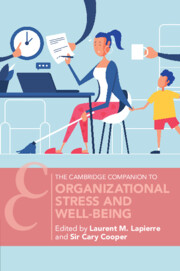Book contents
- Organizational Stress and Well-Being
- Cambridge Companions To Management
- Organizational Stress and Well-Being
- Copyright page
- Contents
- Figures
- Tables
- Contributors
- Introduction
- Part I Historical Evolution and Continued Relevance of the Study of Organizational Stress and Well-Being
- Part II Line Managers
- 4 Is It Stressful at the Top?
- 5 The Role of Line Managers in Promoting and Protecting Employee Well-Being
- Part III Major Issues Relating to Stress and Well-Being
- Part IV Workplace Interventions Addressing Stress and Well-Being
- Part V Emerging Issues
- Subject Index
- References
4 - Is It Stressful at the Top?
The Demands of Leadership in Times of Stability and Crisis
from Part II - Line Managers
Published online by Cambridge University Press: 23 February 2023
- Organizational Stress and Well-Being
- Cambridge Companions To Management
- Organizational Stress and Well-Being
- Copyright page
- Contents
- Figures
- Tables
- Contributors
- Introduction
- Part I Historical Evolution and Continued Relevance of the Study of Organizational Stress and Well-Being
- Part II Line Managers
- 4 Is It Stressful at the Top?
- 5 The Role of Line Managers in Promoting and Protecting Employee Well-Being
- Part III Major Issues Relating to Stress and Well-Being
- Part IV Workplace Interventions Addressing Stress and Well-Being
- Part V Emerging Issues
- Subject Index
- References
Summary
A textbook on organizational stress and well-being wouldn’t be complete without taking a closer look at the stress and well-being of organizational leaders. Leaders’ physical and psychological health can decline, partly due to the demands of their jobs. However, while the job demands of a leadership position are higher than those of other employees, leaders typically have more access to various types of resources. This provokes the question: Is it stressful at the top? Leaders nowadays generally work in work environments characterized by volatility, uncertainty, complexity, and ambiguity. However, (effective) leadership becomes even more relevant during times of crisis. This chapter therefore compares leader job demands in the non-crisis and the crisis contexts. The chapter concludes by giving some suggestions on how to cope with leaders’ job demands by looking at two potential strategies for leaders to use – mindfulness and the social identity approach.
- Type
- Chapter
- Information
- Organizational Stress and Well-Being , pp. 93 - 122Publisher: Cambridge University PressPrint publication year: 2023

